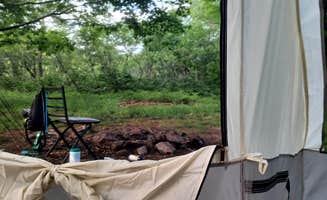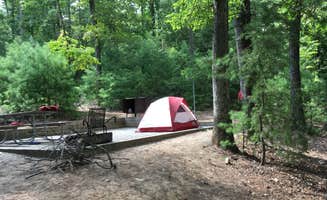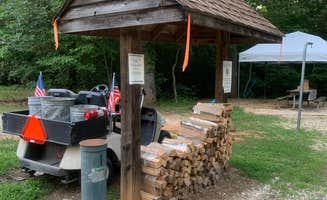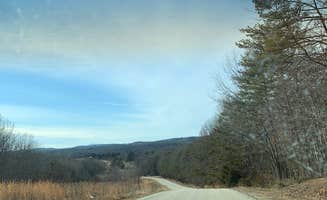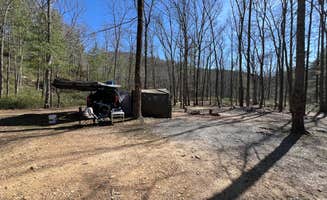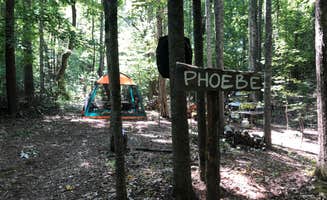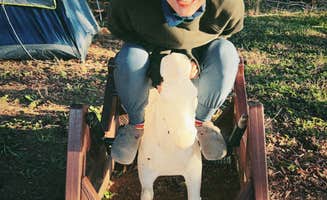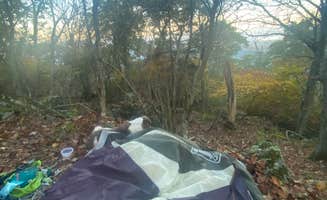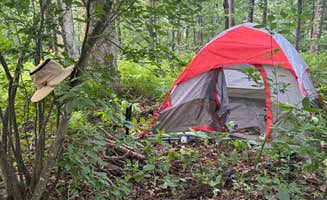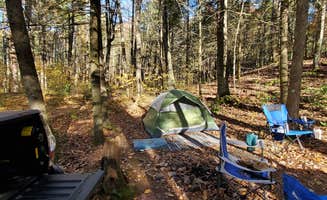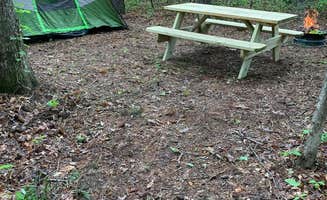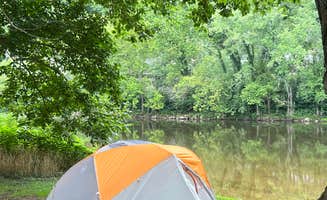Tent camping near Nellysford, Virginia encompasses a variety of elevations, from 650 feet in river valleys to over 3,000 feet at mountain sites in George Washington National Forest. The region experiences distinct seasonal changes, with summer nighttime temperatures averaging 60-65°F at lower elevations while mountain sites can drop to 50-55°F. Fall camping season extends into late October when deciduous trees display peak color between 2,000-3,000 feet.
What to do
Fishing access from campsites: Canoe Landing Group Campsite offers direct fishing opportunities within walking distance of tent sites. One camper noted, "You can fish right off the bank less than 50 yards from your tent." The James River provides habitat for smallmouth bass, catfish, and sunfish.
Stargazing without light pollution: The higher elevation campsites provide exceptional night sky viewing conditions. A camper at Walnut Grove mentioned it as "The best place for star gazing! Just ask for a telescope (free at the store) and stare up at the sky for hours!" Most mountain sites have minimal artificial light interference.
Paddling opportunities: Water activities remain accessible through fall. A reviewer stated, "Lake James is by far the clearest body of water I have been on in NC. Kayaked to the Long Arm camping area #1 and stayed at campsite #6." Sites near water bodies typically offer shoreline suitable for launching small watercraft.
What campers like
Privacy between sites: Many campers value separation from other groups. A visitor to Switzer Lake Dispersed Camping shared, "I've camped here probably 12 times over the past 2 years and I seem to always find another awesome spot every time I go. There is a huge variety of spots, starting from huge ones right on the lake to more secluded, smaller spots deeper in the woods along the creek."
Clean facilities at established campgrounds: Maintained bathhouses receive consistent praise. One camper at Walnut Grove observed, "The bathhouse was immaculate and the campsite large enough for two tents to share comfortably." Another noted, "Bathhouse looked like it was fairly new. Loved that the showers were individual stalls accessed on the outside of the bathhouse."
Natural swimming areas: Tent campers appreciate cooling off in natural water. A visitor to Branch Pond mentioned, "We stayed in Long Arm paddle-in area 2. Park staff was not very helpful at all when we first arrived, but despite the attitude and the terrible rainy weather, we found our site fairly easily." Swimming conditions vary by water level and season.
What you should know
Access road conditions: Several dispersed camping areas require travel on unmaintained roads. A camper at Switzer Lake advised, "The road is a mix of gravel but also dirt so it can become muddy during rain. If you follow the road, there is a river crossing that will take you to additional camp spots. The road beyond the river can get more tricky for low clearance vehicles."
Bear activity requires proper food storage: Wildlife encounters are common throughout the region. A camper noted, "There are bears here, so lock up your food in the car. We have encountered a bear at or around the campsite 3 times." Most established campgrounds provide metal food storage boxes at campsites.
Cell service limitations: Digital connectivity varies significantly by location. A visitor to Dispersed Camping Site off FR 812 reported, "No cell service (T-Mobile), but if I drove towards the main road, Route 501, I could get some service." Another camper at Hog Camp Gap noted, "Cell service is poor I have u.s. cellular and I had one bar sometimes no bars data service was in and out."
Tips for camping with families
Consider walk-in distance when selecting sites: Some campgrounds require carrying gear from parking areas to tent sites. A camper at Walnut Grove explained, "The only possible negative which is only negative if, like me, you take too much stuff, is that it's quite a walk from the parking area to the campsites. And it's downhill from the car to the sites."
Evaluate swimming safety by location: Water access points vary in safety for children. A reviewer cautioned about James River, "Note though—would be careful swimming with children. Most areas are very calm but the river can get rapid at times!" Established beaches at some sites provide safer alternatives.
Look for educational opportunities: Hawk Nest Mushroom Farm offers unique learning experiences for children. A camper shared, "The camp host Orv has a very unique campsite setup not too far from the house/mushroom farm area. We got a nice tour of the mushrooms currently growing at the farm." Several area campgrounds offer junior ranger programs on weekends.
Tips from RVers
Site leveling considerations: RV campers should prepare for varying terrain. A camper at Lynchburg KOA noted, "Sites are huge and level." However, at dispersed sites, leveling can be challenging, especially after rainfall when ground softens.
Navigating narrow forest roads: Several camping areas have access limitations. A reviewer advised, "Prepared to drive another 2ish miles on a single lane and very bumpy dirt road. Go slow as several sharp corners with huge drops and inexperienced drives coming towards you." RVs over 24 feet may find many forest roads impassable.
Water access planning: Non-established sites require bringing all water. A camper at Hog Camp Gap mentioned, "There is a spring but remember to boil or chemical treat the water before use is not tested for parasites another humble bacteria." Most established campgrounds provide potable water access at central locations rather than individual sites.


